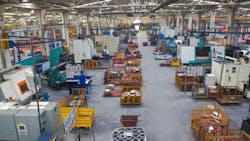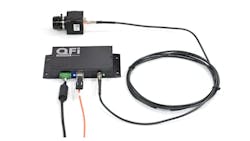From Meters to Miles: Long Distance Machine Vision with CoaXPress over Fiber
CoaXPress (“CXP”) is a well-defined open interface for demanding machine vision tasks such as automated optical inspection, medical imaging, life sciences and industrial quality control. The interface’s support of data rates up to 12.5 Gbps per link (or up to 50 Gbps with four links) enables transmission of higher resolution images at faster frame rates, crucial for machine vision system success. Also, CXP’s use of 75-ohm coaxial cable as a transmission medium has made CXP an ideal upgrade for older coax-based analog systems, for instance, in intelligent traffic systems (ITS), or in military and aerospace systems.
In this article, we will address an emerging application for CoaXPress: the running of the unmodified CXP protocol over long-distance fiber optic cables.
Related: Monitoring Critical Infrastructure with AI-Based Computer VIsion
Fiber’s traditional benefits—high bandwidth, immunity to electromagnetic interference (EMI), safety, durability, and compact dimensions—makes it a perfect match for CoaXPress. While CXP’s maximum cable range of 40 meters is ample length for the majority of in-plant machine vision systems, it falls short when applications are measured in miles rather than meters. It is at these distances that fiber truly shines. Single-mode fiber allows for the remote inspection and video monitoring of targets up to 120 kilometers (~75 miles) away from a host with little to no signal degradation due to attenuation and dispersion. Compared to copper-based systems, fiber optics are also intrinsically more secure against tampering or eavesdropping since it is challenging to tap into them without physically accessing the cable. For long-distance surveillance, this security can be critical.
Long Distance Machine Vision
For the purpose of this article, the term “long distance machine vision” will describe any advanced imaging system that is intended to capture, process and analyze video beyond the standard 100-meter limitations of Ethernet. Let’s look at a few scenarios where CXP and fiber can be used:
- Pipelines: Examining pipeline interiors for leaks, corrosion, or cracks, particularly in isolated or dangerous areas.
- Infrastructure: Monitoring stress, vibrations, and other damage to wind turbine blades, bridges, and major structures.
- Remote sites: Inspection of hard-to-reach areas like inside machinery, processing tanks, or aircraft components. These areas may contain explosive liquids, vapors or dust. Also, this would apply to destructive testing situations.
- Surveillance/Defense: Used to remotely observe, track, and engage high-value surveillance targets such as military bases. Also used in securing borders and supporting intelligence or reconnaissance missions.
- Industrial Automation: Monitoring large factories or assembly lines where cameras are spread out.
- Underground: Inspecting the condition of sewer lines, cables, or tunnels.
- Aerospace: Close monitoring of all aspects of a rocket launch.
Fiber performs far better than copper in long distance transmission and is more cost effective. In order for a data signal to travel long distances over a twisted-pair copper cable, it would need to be amplified many times. Although expensive, so-called repeaters could be used for this. Even though fiber-optic cables can cost more per meter than copper cables, they can be the more affordable option over long distances due to the cost of repeaters. Additional to this, the repeaters will need a source of power which involves extra costs and design.
GigE Vision + Fiber
The standard approach to long-distance imaging applications is to use GigE Vision protocol cameras. Most GigE Vision cameras work over fiber with standard Ethernet hardware, as the protocol is agnostic to the physical medium.
To set up a GigE Vision system, the cameras are connected to a pair of copper-to-fiber media converters—one near the camera to convert the Ethernet signal to fiber, and another near the host to convert it back to copper—with a fiber optic cable span in between them. Another approach would be an industrial Ethernet switch with fiber optic ports to connect the camera via copper, then use fiber to link the switch to the host system over long distances. In addition, some more advanced GigE Vision cameras or frame grabbers support SFP modules, allowing direct connection to fiber optic cables without external converters. The GigE Vision protocol itself remains unchanged—it’s simply transported over the fiber optic medium.
Related: How GigE Vision 3.0 Fits in the Machine Vision Ecosystem
While GigE Vision offers many advantages—such as cost-effectiveness, widespread compatibility, and leveraging standard Ethernet infrastructure—it does have some limitations that can impact its suitability for long distance fiber applications. Drawbacks of the approach include an increased cost of installation due to the specialized fiber optic equipment needed, the complexity of setting up the fiber connections, and the high CPU load when applications entail heavy image processing.
Although GigE Vision can leverage the 100 Gbps capabilities of Ethernet networks, the standard itself does not inherently operate at that speed. In fact, most GigE Vision cameras currently operate at a standard Gigabit Ethernet speed of 1 Gbps, which translates to a practical maximum data rate of about 100-125 MBps after overhead. Cameras with higher resolution sensors or those operating at higher frame rates of 60 fps+ can exceed this bandwidth, causing bottlenecks.
So, what about 10GigE Vision? The vision market initially welcomed 10GigE Vision’s 10x increase of the GigE Vision protocol’s 1G bandwidth. However, what became clear over time was that CPUs could not handle the 10 Gbps traffic, resulting in latency and dropped frames. GigE Vision relies on the host computer’s CPU to process Ethernet packets and manage data streams, unlike frame grabbers used in CoaXPress or Camera Link. Smart NICs or a 10G frame grabber with offloading capabilities can reduce CPU utilization but this approach cancels out the primary advantage of GigE Vision over CoaXPress: not requiring a frame grabber as an intermediary between the camera and the PC. Older cable infrastructures must also be upgraded with CAT6 or CAT6a to accommodate 10GigE Vision, further adding to system costs.
The 10GigE Vision protocol's high-power consumption, which causes cameras to overheat, is another disadvantage in long-distance applications. Other drawbacks are its inability to send real-time triggers or connect multiple cameras to the same PC, and the non-deterministic frame latency causing frames to arrive with significant time jitter. All of these problems are exacerbated in long distance system applications.
Related: Extending the Benefits of CoaXPress with CoaxPress over Fiber
GigE Vision is a versatile and affordable choice for basic machine vision applications, but its drawbacks make it less ideal for long-distance tasks where its initial low cost of entry can quickly escalate. Of course, as an Ethernet-based protocol, GigE Vision is vulnerable to network-based attacks such as packet sniffing and unauthorized access, if not properly secured.
CXP + Fiber
In 2021, the 2.1 version of the CoaXPress standard was released by the Japan Industrial Imaging Association (JIIA) standards committee and adopted per the agreement of the Global Coordination of Machine Vision Standards (G3) Agreement soon after. Key upgrades were the support for additional speeds (CXP-10 and CXP-12), doubling of the uplink speed for triggering at over 500kHz, GenICam and GenDC compliance, and the adoption of Micro-BNC connectors.
Lost in all this news was the add-on of CoaXPress over Fiber to the version 2.1 specification. This was groundbreaking, enabling fiber optic links to work with the CoaXPress protocol, unmodified. The physical layer for transmission is based on Ethernet standards, which makes it easier to integrate with current network infrastructure even though the data protocol is still CoaXPress. CXP data is encoded onto the fiber using standard Ethernet signaling such as 10GBASE-R for 10 Gbps, ensuring compatibility with existing fiber networks.
Related: What's New in CLHS Version 1.2?
As we mentioned earlier, the CoaXPress standard defines bit rates up to 12.5 Gbps (CXP-12) with speeds supported by serial data technology. Version 2.1 sets the stage for future 25G CXP (CXP-25, CXP-31) transmission and goes beyond its defined bit rates and cable lengths. The primary gateway to the 10G Ethernet physical layer is the 10 Gigabit Media Independent Interface (XGMII). This interface's generic design makes it easier to map CoaXPress signaling into Ethernet sublayers. Furthermore, without the 8b/10b encoding overhead, an XGMII interface has an effective bit rate equal to a CoaXPress CXP-12 connection. Using XGMII also gets CoaXPress ready to support higher bandwidths via the 25 Gigabit Media Independent Interface (25GMII). The 25GMII is a faster version of the XGMII while being logically equivalent to it.
CoaXPress over fiber exhibits identical or better performance as CoaXPress over coaxial cables in terms of jitter and latency due to fiber’s 10 and 25 Gbps bandwidth connectivity. According to the 2.1 specification, CoF’s maximum distance over single-mode fiber is 120 kilometers (~75 miles) or 550 meters (600 yards) over multimode fiber. The only potential drawback to CoF is fiber’s inability to transfer power over light.
Related: GenICam: In the Engine Room of Machine Vision
In response to the 2.1 specification manufacturers, including BitFlow, introduced CoaXPress over Fiber frame grabbers, range extenders, and cameras.
Converting CXP to Optics
As with GigE Vision camera solutions, CoaXPress electrical signals must be converted to optical signals for long-distance transmission. CXP data is transmitted as packets comprised of image data and additional bits for validation and synchronization.
Related: Transmission Standards in Machine Vision
Conversion can be performed in one of three ways.
- Convert the camera’s CXP output to fiber using a dedicated set of converter boxes with a long run of fiber cable in between. At the PC end, the signal is converted back to copper and plugged into a CXP frame grabber. While this is a viable configuration, it may be cost prohibitive.
- Another solution is where a camera manufacturer will redesign their non-CoF CXP camera with a fiber interface. The issue here is that in order to integrate a fiber output, a standard CXP camera, especially the single and dual link CXP lower costing units, which normally feature a very small footprint, would need to grow significantly in size and power. Realistically, the modest ROI for the camera maker could make this cost prohibitive.
- There is now a third connectivity alternative. New copper-to-fiber modules have been developed that solve the long-distance machine vision challenge by taking a minimal parts approach. Rather than two cumbersome media converter boxes, only one module is needed that directly connects to a non-CoF CXP single-link camera via a standard coaxial cable. Unlike with other copper-to-fiber solutions, these new modules also supply 13W of power to the camera, eliminating the need for an external power source. Plus, it fully supports an uplink channel accommodating camera configuration and control, triggering and firmware updates. The module outputs to a single-mode fiber cable streaming data at a constant 10 Gbps. This fiber cable, which can run 120 kilometers or longer without signal degradation, plugs directly into a CXP fiber frame grabber inside the host PC.
Due to constant innovation, more CoaXPress over Fiber options are certain to arise, offering greater cost efficiencies, higher speeds, and longer cable reach.
In conclusion, fiber transmission provides high data integrity over long distances due to the inherent isolation of light signals. CoaXPress-over-Fiber is a way to run the CoaXPress protocol, unmodified, over standard Ethernet connections including fiber optics, opening the door to far higher bandwidth. Coupled with CXP benefits of low CPU overhead, low latency, and low jitter image acquisition, CoaXPress-over-Fiber is emerging as a viable alternative to GigE Vision systems.
About the Author

Donal Waide
Donal Waide is the global director of business development for frame grabbers, part of the Industrial Cloud and Video Group, Advantech (Taipei, Taiwan). He became a member of the Advantech team in October 2023 after Advantech acquired Waide's previous employer, BitFlow (Woburn, MA, USA), where Waide was the Director of Sales, a role he held for 13 years. Educated at the University of Limerick, Ireland, he now resides just outside Boston, MA, USA, where he has lived for over 30 years. Waide has been involved in the machine vision world since 1997.


